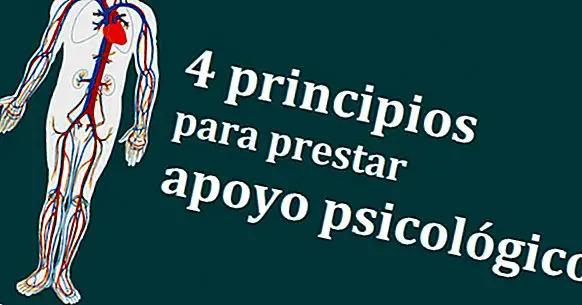4 basic principles for providing psychological support in emergencies
At any time, whether we are psychologists or not, we can find ourselves in a situation that requires our intervention . For example, we may encounter a complicated situation in many different situations, such as in an accident on the road or in an incident on a trip.
In another article of Psychology and Mind We already talked about the role of psychology in emergencies and disasters, and today we will delve into some practical keys to help people who need it, regardless of whether we are mental health professionals, or not.
Humans are social beings and, especially in the summer, we move from one place to another with high temperatures and are more likely to find ourselves in situations in which we have to attend and help, within our possibilities, to another person or family that has suffered an incident.
General principles for giving psychological help
With this aim and without intention to deepen, since the bibliography is wide, I intend to summarize in four basic principles the keys to provide psychological support to someone who needs it .
Based on my experience in both the social and health field, which has involved attention in emergencies and emergencies or in other cases in contexts of high emotional stress, there are a series of steps that coincide in all bibliographic references on emergencies that , I believe, are key to making a first attention before the specialized teams come. These premises will guide you and the people you serve , and will provide security, emotional ventilation and relief to the people we will serve.
These principles will follow the pre-established order, and I will expand with an example a posteriori: the first thing will be to give the warning by calling emergencies, they will give us guidelines that will allow us to analyze the situation before approaching and presenting ourselves. Once we are in front of the people we want to help, we will introduce ourselves and inform them that we have called for emergencies and that specialized help is warned and is on the way. Finally, we will listen and facilitate emotional expression by staying by your side until help arrives, if it is within our means.
I will detail each of the steps to make it easier to understand what we should do in case someone needs our psychological and emotional support.
1. Give emergency notice
A truism, perhaps, but its importance and the need to go in point 1 is totally unquestionable.
Even so, I was surprised to hear stories of people who "had not fallen" to call emergency . Fortunately, thanks to social awareness and the media, the 112 telephone and the rest of the emergency operations are the best known and almost everyone hurries to notify emergencies when an accident happens.
The variety of situations we can find is wide: car accidents, floods, fires, lonely and disoriented old people or children. We can also witness situations of violence (street, mistreatment of couple, family, or others), hear screams or people who cry for help, and a long etcetera.
In these situations you should always call emergency , and the professionals that will attend your call are those who will assess the seriousness of the situation and what devices to send to the area (ambulance, firemen, police, etc.). Today, everything is centralized and we only have to describe what we see during the call.

2. Analyze the situation and approach with prudence
During the emergency call, the operator will make us observe and ask us about the location and the type situation to be informed about what is happening .
For example, if someone faints in front of us, they will ask us if they are conscious, if they breathe, etc. These same questions will guide us about what will happen afterwards, and the operator itself will give us security instructions (for example, if there is an accident, it will recommend us where to go to avoid problems) and will inform us of the approximate delay time .
3. Introduce, inform and guide
It is crucial to introduce ourselves . Approach the affected person calmly and tell them how we call ourselves, who we are and why we are there. For example: "Hello, my name is María. I have seen your motorcycle on the road and I have given the emergency warning. " And ask him his name, remember that he is a person and the presentations humanize us.
At this point inform the situation is key, misinformation anguish to people who are in a situation of this type. You will only have to tell them what they have transferred you when you have given the notice and when they will take , trying to influence positive language using terms such as "soon" given that the victim of the situation will already be very distressed. We can encourage calm with some phrases, such as "I already warned and the ambulance is on its way. They also told me that it is better that you do not move, soon they will arrive ".
It is important that you control your tone of voice and your non-verbal language; stay in your field of vision, with eye contact when you speak or speak to you, ask before touching the person if you want to help and not invade your living space if you do not give permission. Your role is not to replace the sanitary technicians, it is about the person being comfortable and accompanied until then .
Once informed and oriented, we can say something to comfort the injured or troubled person, such as waiting for her and being interested in her condition, which would be phase 4.
4. Listen and facilitate emotional expression
Be interested in what has happened, facilitate their emotional expression and stimulate their dialogue . When you ask and do not interrupt when I explain and stay receptive to an active listening state, it is enough.
You can, if you are comfortable at some point to paraphrase / recap to give feedback that you understood it to situate it and mitigate its anguish, using its own terms, for example: "What you tell me is that you hit that tree from the right side of the motorcycle". Even when the technicians come, the fact of paraphrasing will help you remember information to transmit it to professionals , if the person is unconscious or too stunned to speak.
If you verbalize or externalize emotional expressions such as crying and being ashamed, you must support that feeling and facilitate its expression, with phrases such as "it is normal that you feel this way, you have had an accident, but the ambulance is already on the way".
During the wait, stay accessible, applying active listening. If you are receptive, you will be able to detect and observe needs that are not verbalized and facilitate their expression.



















